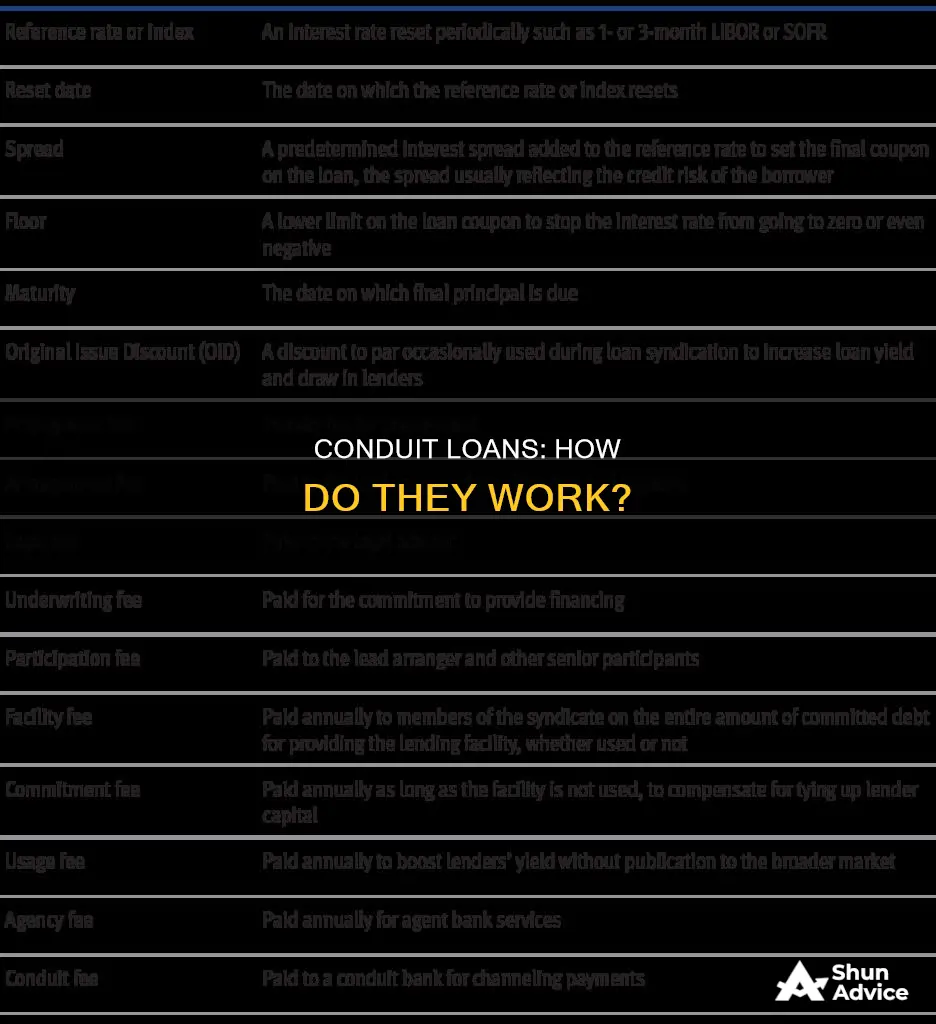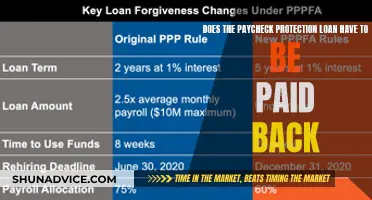
A conduit loan, also known as a CMBS (Commercial Mortgage-Backed Security) loan, is a commercial real estate loan secured by a mortgage on a commercial property. These loans are structured by conduit lenders, commercial banks, or investment banks. Conduit loans are often appealing because they are fixed-rate loans with low interest rates and are typically offered on a non-recourse basis. However, the standard securitization structure for these loans can make them complex, and they may not be the best option for every borrower.
| Characteristics | Values |
|---|---|
| Type | Commercial mortgage |
| Security | Mortgage on a commercial property |
| Structure | Pooled with other loans and held in trust |
| Lender | Conduit lenders, commercial banks or investment banks |
| Borrower | Organizations or individuals with a minimum net worth |
| Interest rate | Competitive, based on U.S. Treasury rates plus a margin or spread |
| Prepayment | Defeasance or yield maintenance |
| Risk | Higher risk than traditional municipal bonds |
| Taxation | Not subject to taxation |
What You'll Learn

Conduit loans are a type of commercial mortgage
Conduit loans, also known as CMBS (Commercial Mortgage-Backed Security) loans, are a type of commercial mortgage. They are secured by a mortgage on a commercial property, and are typically structured by conduit lenders, commercial banks, or investment banks. Conduit loans are often appealing because they are fixed-rate loans that carry low rates and are usually offered on a non-recourse basis.
Conduit loans are structured as permanent, fixed-rate commercial real estate loans. They are packaged with other similar loans, securitized, and sold to investors. The loans in the pool are held in trust and serve as collateral for the mortgage-backed security. The secondary market for these securities is large and provides liquidity to the commercial mortgage market. The mortgage-backed security is typically broken up into tranches, which are securities with different levels of risk, return, and maturities.
Conduit loans are predominantly underwritten based on the likelihood of the income stream continuing and increasing throughout the life of the loan. They are non-recourse loans with no personal guarantee from the sponsors and carry longer terms than portfolio loans. The interest rates for a conduit loan are based on the swap rate plus a margin or spread, which is designed to compensate the lender/investors for their risk. The spread is determined by market factors and the risk of the individual loan.
Conduit loan borrowers will often have to pay defeasance to prepay their loan. Defeasance involves the borrower purchasing an equivalent number of substitute bonds to replace the income provided by their loan. Prepayment penalties can also take the form of yield maintenance, which is based on a minimum yield to the investor that purchased the commercial mortgage-backed security.
Understanding Gift Loans: What, Why, and How?
You may want to see also

They are secured by a mortgage on a commercial property
A conduit loan, also known as a CMBS (Commercial Mortgage-Backed Security) loan, is a type of commercial mortgage that is packaged into a pool with other similar types of commercial loans. These loans are secured by a mortgage on a commercial property. Conduit loans are structured by conduit lenders, commercial banks, or investment banks.
Conduit loans are made up of commercial real estate first mortgage debt, which is pooled together and held in a trust. The commercial loans are single loans of varying property types, loan sizes, and locations. The trust then releases a series of bonds of varying yield, duration, and payment priority. Investors choose which bond they would like to purchase based on their appetite for risk, yield, and duration. Pooling together single loans makes them more attractive to investors and allows them to enter the commercial mortgage market. This increases the funding available for commercial mortgage loans and forces mortgage loans to be aggressively priced.
Conduit loans are typically permanent, fixed-rate commercial real estate loans on a non-recourse basis. They are underwritten based on the likelihood of the income stream continuing and increasing throughout the life of the loan, with the asset value and sponsor credit as secondary concerns. The interest rates for a conduit loan are based on the swap rate plus a margin, or spread, designed to compensate the lender/investors for their risk. The swap rate varies based on market factors, while the spread is determined by both market factors and the risk of the individual loan.
Conduit loans are often appealing because they carry low rates and are typically offered on a non-recourse basis. However, the standard securitization structure for these loans can also be a drawback for borrowers due to the complexity and extensive regulations and requirements involved.
Title Loans in Ohio: What's the Legal Status?
You may want to see also

Conduit loans are structured by conduit lenders, commercial or investment banks
Conduit loans, also known as CMBS loans, are commercial real estate loans secured by a mortgage on a commercial property. These loans are structured by conduit lenders, commercial banks or investment banks.
Conduit loans are a type of commercial mortgage that is packaged into a pool with other similar types of commercial loans and sold in the secondary market to institutional investors. This process is known as securitization. The loans in the pool are held in trust and serve as collateral for the mortgage-backed security. The trust then releases a series of bonds of varying yield, duration and payment priority. Investors choose which bond they would like to purchase based on their appetite for risk, yield and duration. Pooling together single loans makes them more attractive to investors and allows them to enter the commercial mortgage market.
Conduit loans are typically non-recourse loans with no personal guarantee from the sponsors and carry longer terms than portfolio loans. They are usually offered on a fixed-rate basis, with competitive interest rates based on US Treasury rates plus a margin or spread. The spread is determined by various factors, including property quality and condition, quality of management, quality of tenants and property cash flow.
Conduit lenders typically require borrowers to have a minimum net worth and a minimum debt service coverage ratio (DSCR). The maximum loan-to-value (LTV) ratio is usually 75%, and the loan term is typically 10 years. Conduit loans commonly start at $2 million, though some lenders will go as low as $1 million.
Harmony Loans: Understanding the Basics of This Financial Option
You may want to see also

Conduit loan interest rates are generally competitive
Conduit loans, also known as CMBS (Commercial Mortgage-Backed Security) loans, are commercial real estate loans secured by a mortgage on a commercial property. These loans are structured by conduit lenders, commercial banks, or investment banks.
Conduit loans are often attractive to borrowers due to their fixed-rate nature and competitive interest rates, which can be as low as 4.30%. These loans are typically non-recourse, meaning borrowers are not personally liable for repayment, and the loan remains tied to the commercial property serving as collateral. The fixed-rate nature of conduit loans provides borrowers with the advantage of not having to worry about fluctuating interest rates throughout the life of the loan.
Conduit loans are also unique in that they are pooled together and held in a trust, creating a series of bonds with varying yields, durations, and payment priorities. This pooling of loans makes them more attractive to investors, increasing the funding available for commercial mortgage loans and resulting in aggressive pricing. The large secondary market for these securities provides significant liquidity to the commercial mortgage market.
Explore Rural Opportunities with a Development Loan
You may want to see also

Conduit loans are packaged with other loans and sold to investors
Conduit loans are pooled together and held in a trust. The commercial loans are single loans of varying property types, loan sizes, and locations. The trust then releases a series of bonds with varying yields, durations, and payment priorities. Investors choose which bond they would like to purchase based on their appetite for risk, yield, and duration. Pooling single loans together makes them more attractive to investors and allows them to enter the commercial mortgage market. This increases the funding available for commercial mortgage loans and forces mortgage loans to be aggressively priced.
Conduit loans are typically non-recourse loans with no personal guarantee from the sponsors, and they carry longer terms than portfolio loans. They are also usually fixed-rate loans, which means borrowers don't have to worry about rates fluctuating during the life of the loan. The interest rates for conduit loans are based on the swap rate or U.S. Treasury rate, plus a margin or spread. This spread is determined by factors such as property quality, management quality, tenant quality, and property cash flow.
Conduit loans are often appealing to borrowers due to their low fixed rates and non-recourse structure. However, the standard securitization structure for these loans can also be a drawback due to the complexity and extensive regulations involved.
Steps to Become a Loan Signing Agent in Georgia
You may want to see also
Frequently asked questions
A conduit loan, also known as a CMBS (Commercial Mortgage-Backed Security) loan, is a commercial real estate loan secured by a mortgage on a commercial property.
Conduit lenders are typically Wall Street brokerage firms, commercial banks with a capital markets group, or finance companies that originate the loan with the intent to sell.
Conduit loans are appealing because they are fixed-rate commercial real estate loans that often carry low rates and are typically offered on a non-recourse basis. They also have flexible underwriting guidelines, access to capital without the scrutiny of traditional loans, leverage up to 75%, and competitive interest rates.
The main disadvantage of a conduit loan is that the borrower may not get a great servicing experience. This is because CMBS lenders don't service these loans themselves but hire a third-party servicer. Additionally, the standard securitization structure for these loans can make them complex and may have characteristics that are drawbacks for the borrower.







